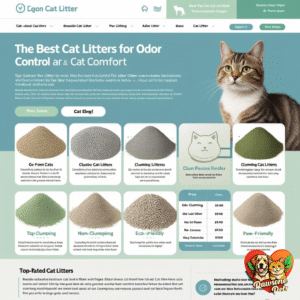
The Best Cat Litters for Odor Control and Your Cat's Comfort
Understanding Cat Litter Types
Choosing the appropriate cat litter type is essential for odor management and ensuring your cat’s comfort. The market offers various options, including clumping, non-clumping, natural, and crystal litters, each possessing unique characteristics and benefits.
Clumping litters, often made from clay materials such as sodium bentonite, form solid clumps when wet. This enables easy removal of waste and helps contain odors effectively. Many cat owners prefer this type due to its convenience and efficacy in managing smells. However, some cats may be sensitive to the texture or dust created during use, making it crucial to observe their reactions.
In contrast, non-clumping litters typically absorb moisture without forming clumps. These products are often made from clay or recycled paper products and can be effective for odor control, though they may require more frequent changes than clumping varieties. Some owners opt for this type for kittens, as it is generally softer and less abrasive on delicate paws. However, the downside to non-clumping litters is the challenge in removing waste effectively, which might lead to odor issues if not maintained properly.
Natural litters comprise biodegradable materials like corn, pine, or wheat. They are praised for their eco-friendliness and often feature pleasant scents that can neutralize odors naturally. While many cats appreciate the softer texture of these litters, they may not always provide the same level of odor control as synthetic options, particularly in multi-cat households.
Lastly, crystal litters utilize silica gel crystals that absorb moisture and deodorize effectively. They are low in dust and often last longer between changes. However, some felines may find the sharp texture uncomfortable, necessitating a careful evaluation of their preferences.
It is important to recognize that each cat has different responses to litter types, depending on factors such as age, sensitivity, and personal preference. Consequently, experimenting with various options may be beneficial in finding the ideal balance between odor control and comfort for your feline friend
Top Cat Litters for Odor Control
When it comes to managing the odors associated with cat litter, the market offers a range of options designed specifically for odor control while ensuring the comfort of your feline companion. Among the top choices, clumping clay litters stand out due to their ability to form solid clumps when wet, aiding both cleaning and odor management. One highly recommended product is the Dr. Elsey’s Precious Cat Ultra Cat Litter. This litter not only clumps effectively but also contains natural ingredients that help to neutralize odors, making it a favorite among cat owners.
Another contender is the Tidy Cats Double Duty Cat Litter, known for its dual-action odor control. It incorporates activated charcoal to eliminate strong odors while providing excellent clumping action. Many users have praised its ability to manage litter box smells even in multiple-cat households, making it a practical choice for families with several pets.
For those who prefer a more eco-friendly option, the World’s Best Cat Litter offers a corn-based formula designed to clump well and provide excellent odor control. Customers often highlight how this product is not only effective but also gentle on the environment, addressing the concerns of eco-conscious pet owners.
Price points for these litters vary, with clay and natural options generally ranging from $10 to $30 for a 20-pound bag. While the initial investments might differ, choosing a litter that effectively controls odors can lead to long-term savings, as less frequent changes may be necessary. Ultimately, the choice of cat litter should balance cost and performance, ensuring both you and your cat enjoy a more pleasant and odor-free environment.
Factors to Consider for Your Cat's Comfort
When selecting a cat litter, it is essential to prioritize your pet’s comfort, which can significantly impact their overall well-being. One of the primary factors to consider is the texture of the litter. Cats have particular preferences regarding the feel of the litter beneath their paws. Soft, fine-grained litter often mimics natural substrate and is generally preferred by felines. Conversely, some cats may dislike the coarse litter, as it can cause discomfort and deter them from using the box.
Dust is another critical factor for your cat’s comfort. Many cat litters produce dust when poured or when cats dig through them, which can be irritating for both felines and their owners. Low-dust or hypoallergenic options are advisable, particularly for cats with respiratory issues or sensitivities. It is also beneficial to evaluate scent options. While some cat owners might be inclined to choose scented litters for odor control, many cats prefer unscented options. Strong fragrances can be overwhelming and may discourage your cat from using the litter box.
The depth of the litter and the cleanliness of the litter box are equally vital. A layer of approximately two to three inches of litter is typically recommended, allowing cats to dig and bury their waste comfortably. Regular maintenance, including daily scooping and complete litter changes, ensures a hygienic environment that encourages consistent usage. Transitioning to a new litter can be a delicate process; to ensure your cat adapts comfortably, consider mixing the new litter with the old gradually, slowly increasing the new litter’s proportion. This strategy minimizes stress and helps your feline companion adjust smoothly to their new toilet environment.
Maintaining a Fresh and Comfortable Litter Box
Maintaining a clean and odor-free litter box is crucial for your cat’s comfort and well-being. One of the most effective practices in ensuring a pleasant environment is to scoop the litter box daily. By removing clumps of waste and soiled litter, you can significantly reduce odors and keep the litter box more inviting for your feline friend. Regular scooping not only helps in odor control but also encourages the cat to use the litter box without hesitation, preventing any behavioral issues arising from an unkempt space.
In addition to daily scooping, it is essential to conduct a deeper cleaning at least once a week. This involves emptying the litter box completely, washing it with warm soapy water, and thoroughly rinsing it before adding new litter. By removing any residual odors from the box, you create a fresher space for your cat. Utilizing a suitable cleaning agent, such as an unscented dish soap or a mild vinegar solution, can help eliminate odors effectively without leaving any harmful residues.
The location of the litter box also plays a significant role in odor control. A dry, well-ventilated area away from high-traffic zones is ideal. Avoid placing the box in damp or enclosed spaces, as this can exacerbate odor buildup. Additionally, consider using odor-neutralizing products such as baking soda or specially designed litter deodorizers. These can effectively absorb unwanted smells and prolong the freshness of the litter box.
Lastly, observe your cat’s preferences and behavior regarding litter type. If you notice your cat avoiding the box or exhibiting signs of discomfort, it may be time to test a different litter option that offers better odor control or comfort. Different felines have varying tastes, and choosing the right litter can significantly enhance their overall experience. Proper maintenance practices are integral to establishing a healthy and comfortable environment for your cat.

